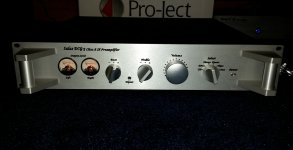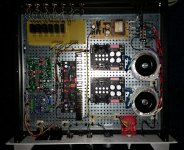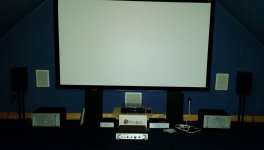Awesome, thanks! So according to that calculator at 333k a 1uf will have a cut off of about 0.48Hz. That should work.  The Audyn+ are pricey but I have experience with them in speaker and amp builds, they sound excellent. Fortunately I have extra room!
The Audyn+ are pricey but I have experience with them in speaker and amp builds, they sound excellent. Fortunately I have extra room!
I'll post some show & tell in a little bit after my phone charges some more.
I'll post some show & tell in a little bit after my phone charges some more.
I apologize for the poor pics but my phone hates darkness, even with the flash.
I did the cnc work on the front panel. The meters are getting blue LEDs inside once it's sorted. The 3rd power supply is 12v for the relays and the meter board. The Velman pre steals it's +/- from the rear DCSTB. The unconnected switch is going to be a tone defeat, someday. I plan on also adding a headphone jack in there too.
I plan on also adding a headphone jack in there too.
I did the cnc work on the front panel. The meters are getting blue LEDs inside once it's sorted. The 3rd power supply is 12v for the relays and the meter board. The Velman pre steals it's +/- from the rear DCSTB. The unconnected switch is going to be a tone defeat, someday.
Attachments
Last edited:
No phones yet and it may be a while for those...unless I win the lottery. 
 The speakers in the system pic are decent but they're temporary. Some 20 year old Polk Audio R50s. Next will be a 12" SB Acoustics 3way (or 4way) that I already have drivers stashed away for.
The speakers in the system pic are decent but they're temporary. Some 20 year old Polk Audio R50s. Next will be a 12" SB Acoustics 3way (or 4way) that I already have drivers stashed away for.  Almost there!
Almost there!

 The speakers in the system pic are decent but they're temporary. Some 20 year old Polk Audio R50s. Next will be a 12" SB Acoustics 3way (or 4way) that I already have drivers stashed away for.
The speakers in the system pic are decent but they're temporary. Some 20 year old Polk Audio R50s. Next will be a 12" SB Acoustics 3way (or 4way) that I already have drivers stashed away for. Pretty cheap! I prefer an around ear type though. When the time comes there's quite a few places nearby that I can go to and listen. I may hit you up for some advice then if it's ok.
Sorry I missed where you mentioned a "quiet set up". Surprisingly it's super quiet. I can barely hear some hiss with the volume at max but only if I put my ear right up to the tweeter. Absolutely no hum at all either. Very nice!
But...I did notice something curious. I powered it up after the meter LED mod (no other mods) and I could hear a faint sizzling noise. I used a long piece of 1/2" shrink tubing up to my ear and moved it around until I located the noise. It was coming from the DCG3 around the relay. It was strongest over the transistor that drives the relay. When powered off the pitch swept up in frequency and stopped. When powered on again there was no noise until the relay clicked on. It gets quieter after left on for a while but still there. Nothing comes through on the audio, just physically from the board. I've heard similar sounds coming from the outputs devices of power amps singing while doing high power testing on dummy a load. Any idea what it could be?
Sorry I missed where you mentioned a "quiet set up". Surprisingly it's super quiet. I can barely hear some hiss with the volume at max but only if I put my ear right up to the tweeter. Absolutely no hum at all either. Very nice!
But...I did notice something curious. I powered it up after the meter LED mod (no other mods) and I could hear a faint sizzling noise. I used a long piece of 1/2" shrink tubing up to my ear and moved it around until I located the noise. It was coming from the DCG3 around the relay. It was strongest over the transistor that drives the relay. When powered off the pitch swept up in frequency and stopped. When powered on again there was no noise until the relay clicked on. It gets quieter after left on for a while but still there. Nothing comes through on the audio, just physically from the board. I've heard similar sounds coming from the outputs devices of power amps singing while doing high power testing on dummy a load. Any idea what it could be?
Sorry it took so long, was waiting for parts before pulling it apart. I put in the 100pf cap and the sizzle is gone! I first tried disconnecting everything but the DCG3 and it was still there so I did the mod. It probably isn't anything catastrophic but something others may want to be aware of.
I tried a Wima MKP 0.1uf coupling cap on the Vellman output and didn't notice any loss in the low end and it still sounded great. I think I'll take your advice and just stick with those and save some $$. The Vellman had some 10R series resistors on the outputs. I removed those and put the caps in their place, should be ok right?
I dropped in the 7R5 source resistors to bump the bias up. I'm getting around 145ma. The power supply voltages dropped a little but still over 17v. I don't know if I'll ever need the higher bias but since I have plenty of heat sink I figured I might as well do it while I had it apart. Then I don't have to take it apart again in the future. It warmed up to about 40c so should be good there. I also have it set to 4x gain.
Got all the resistors changed to Dales in the Vellman and 12.7v zehners installed for the on-board BC550/560 "regulators". Now I have 11.8v for the opamps (was 8.5v). The Burson discrete opamps should be here next week. For the money, I sure hope they're at least a little better than the standard IC types!
I tried a Wima MKP 0.1uf coupling cap on the Vellman output and didn't notice any loss in the low end and it still sounded great. I think I'll take your advice and just stick with those and save some $$. The Vellman had some 10R series resistors on the outputs. I removed those and put the caps in their place, should be ok right?
I dropped in the 7R5 source resistors to bump the bias up. I'm getting around 145ma. The power supply voltages dropped a little but still over 17v. I don't know if I'll ever need the higher bias but since I have plenty of heat sink I figured I might as well do it while I had it apart. Then I don't have to take it apart again in the future. It warmed up to about 40c so should be good there. I also have it set to 4x gain.
Got all the resistors changed to Dales in the Vellman and 12.7v zehners installed for the on-board BC550/560 "regulators". Now I have 11.8v for the opamps (was 8.5v). The Burson discrete opamps should be here next week. For the money, I sure hope they're at least a little better than the standard IC types!
Nice to know that the collector to base compensation cap suggestion has worked. Not mentioned before by builders that the relay driver transistor can resonate in this but if it occurs again its a solution tip for other users to hold. Maybe some unlucky hfe and inductance tolerances combination. Also nice that you saved money on the coupling capacitor front regarding other sections of your combined build. The output resistor on the Velleman should be a damping resistor for better phase margin when driving longish interconnects so if it does not show problems without it in this one box build with your op-amp chip of choice then no worries.
Looking forward to this, came late to the party so will tag along in the next GB(thanks Tea!). Got a pair of quality cans coming late june, the Massdrop HD58X.
My current setup consists of a DCB1 feeding a Fetzilla, and i wanted a dedicated headphone amp, which can double as a pre in case i ever need more gain.
But i'm a sucker for short signal paths, so i'm considering either splitting the input signal from my selector so that it feeds into both the DCB1 and the DCG3, or splitting after the DCB1(i doubt i'd hear much difference), still signal path-wise i prefer option 1.
Should i increase the input termination(decoupling?, i forget the correct term) resistor at whichever inputs i end up "splitting"/doubling up on from 47k to 100k, the idea being that the source should see roughly 47k input impedance?
It is tempting to build everything into one enclosure, a real Salas box feeding both my cans and the Fetzy.
My current setup consists of a DCB1 feeding a Fetzilla, and i wanted a dedicated headphone amp, which can double as a pre in case i ever need more gain.
But i'm a sucker for short signal paths, so i'm considering either splitting the input signal from my selector so that it feeds into both the DCB1 and the DCG3, or splitting after the DCB1(i doubt i'd hear much difference), still signal path-wise i prefer option 1.
Should i increase the input termination(decoupling?, i forget the correct term) resistor at whichever inputs i end up "splitting"/doubling up on from 47k to 100k, the idea being that the source should see roughly 47k input impedance?
It is tempting to build everything into one enclosure, a real Salas box feeding both my cans and the Fetzy.
Last edited:
Any >3mA idss sample and preferably of no more than 2mA idss difference to use between channels will do fine. The LTP's tail CCS forces the units to bias at about 2.5mA Id per LTP side. There the Yfs is the same for any >idss unit because fixed lower on the curve. So no need to have many for producing careful matches.
Hi Salas
Decided to use upa and bought some.... have 5.6mA Idss or 8.6 or 9.5mA pairs.... what would be your choice ?
Consume the low IDSS ones first I would say since they run at 2-2.5mA Id in the dcg3 anyway so to save the higher ones for other higher current ideas if handy.
Curves matching per side is really good in those parts (better than in my LSK389 gold pin samples at least) and their orientation is irrelevant. They mirror flip. Matter of aesthetics from which way you want to read their labeling.
Curves matching per side is really good in those parts (better than in my LSK389 gold pin samples at least) and their orientation is irrelevant. They mirror flip. Matter of aesthetics from which way you want to read their labeling.
- Home
- Source & Line
- Analog Line Level
- Salas DCG3 preamp (line & headphone)


